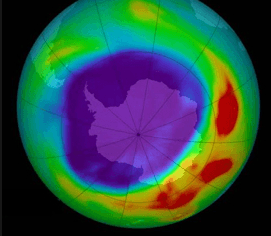Ozone-depleting compound still exists long after ban – Study
 A National Aeronautical Space Agency (NASA) research shows that the earth’s atmosphere contains an unexpectedly large amount of an ozone-depleting compound, the Carbon tetrachloride (CCl4) from an unknown source decades after the compound was banned worldwide.
A National Aeronautical Space Agency (NASA) research shows that the earth’s atmosphere contains an unexpectedly large amount of an ozone-depleting compound, the Carbon tetrachloride (CCl4) from an unknown source decades after the compound was banned worldwide.
CCl4, which was once used in applications such as dry cleaning and a fire-extinguishing agent, was regulated in 1987 under the Montreal Protocol along with other chlorofluorocarbons that destroy ozone and contribute to the ozone hole over Antarctica.
Parties to the Montreal Protocol reported zero new CCl4 emissions from 2007-2012. However, the new research, available to the Ghana News Agency shows worldwide emissions of CCl4 average 39 kilotons per year, approximately 30 per cent of peak emissions prior to the international treaty going into effect.
Qing Liang, an atmospheric scientist at NASA’s Goddard Space Flight Centre in Greenbelt, Maryland, and lead author of the study said: “We are not supposed to be seeing this at all.”
“It is now apparent there are either unidentified industrial leakages, large emissions from contaminated sites, or unknown CCl4 sources.”
It said as of 2008, CCl4 accounted for about 11 per cent of chlorine available for ozone depletion, which is not enough to alter the decreasing trend of ozone-depleting substances. Still, scientists and regulators want to know the source of the unexplained emissions.
The release said scientists for almost a decade have debated why the observed levels of CCl4 in the atmosphere have declined slower than expectations, which are based on what is known about how the compound is destroyed by solar radiation and other natural processes.
“Is there a physical CCl4 loss process we don’t understand, or are there emission sources that go unreported or are not identified?” Liang said.
With zero CCl4 emissions reported, atmospheric concentrations of the compound should have declined at an expected rate of four per cent per year. Observations from the ground showed atmospheric concentrations were only declining by one per cent per year.
Liang and colleagues used NASA’s 3-D GEOS Chemistry Climate Model and data from global networks of ground-based observations. with measurements made by scientists at the National Oceanic and Atmospheric Administration’s (NOAA’s) Earth System Research Laboratory and NOAA’s Cooperative Institute for Research in Environmental Sciences at the University of Colorado, Boulder.
It said model simulations of global atmospheric chemistry and the losses of CCl4 due to interactions with soil and the oceans pointed to an unidentified ongoing current source of CCl4. The results produced the first quantitative estimate of average global CCl4 emissions from 2000-2012.
In addition to unexplained sources of CCl4, the model results showed the chemical stays in the atmosphere 40 per cent longer than previously thought.
The research was published online in the Geophysical Research Letters.
Paul Newman, Chief Scientist for atmospheres at NASA’s Goddard Space Flight Centre, and a co-author of the study said: “People believe the emissions of ozone-depleting substances have stopped because of the Montreal Protocol.”
“Unfortunately, there is still a major source of CCl4 out in the world.”
NASA monitors and develops new ways to observe and study Earth’s interconnected natural systems with long-term data records and computer analysis tools to better see how our planet is changing.
The agency shares the unique knowledge with the global community and works with institutions in the United States and around the world that contribute to understanding and protecting our home planet.
Source: GNA
